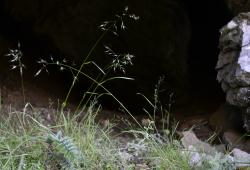- Taxon
- Gallery
Erect, often slender, usually reddish tufts, 12–65–(100) cm, with very lax, sometimes large panicles well overtopping the leaves; branching extravaginal. Leaf-sheath to 6 cm, sometimes reddish, glabrous to pubescent, margins often with longer hairs above. Collar with some long hairs. Ligule 0.2–0.6 mm, truncate, erose, glabrous to minutely or sometimes obviously ciliate. Leaf-blade 3–16 cm × 0.5–2–(6) mm, dull green to later reddish, flat, distinctly ribbed, abaxially smooth, often scabrid towards tip, adaxially minutely pubescent or minutely prickle-toothed on ribs; margins smooth or with very minute prickle-teeth. Culm 6–45–(70) cm, often geniculate at base, internodes glabrous. Panicle 3–20–(28) × 1–10 cm, lax, with very fine, spreading branches bearing individually evident or scarcely overlapping spikelets; rachis smooth below or with few prickle-teeth, more scabrid above, branches and pedicels with slightly denser long fine prickle-teeth. Spikelets 4.5–9 mm, light green to later brownish, usually red-tinged. Glumes very unequal in shape and size, ± hyaline, keels with minute close-set prickle-teeth in upper ½; lower c. ½, or rarely to ¾ or ≈ upper, very narrowly ovate almost subulate, subacute to acuminate, upper < spikelet, broadly ovate, subobtuse to obtuse, rarely acuminate or mucronate; margins entire. Lemma 4.5–7 mm, bicuspid, lower lemma smooth near base, papillose above and on keel, upper lemma(s) almost entirely papillose or minutely prickle-toothed, sometimes all lemmas equally smooth or equally scabrid; awn 5–9 mm, insertion in upper ¼ of lemma. Palea minutely prickle-toothed on upper ⅔ of keels, otherwise smooth. Callus hairs to 0.5 mm. Rachilla hairs to 1.3 mm. Lodicules to 1.3 mm, glabrous or ciliate. Anthers 0.8–1.5 mm. Gynoecium: ovary to 1 mm; stigma-styles to 1 mm. Caryopsis 2–3 × 0.5–0.6 mm. 2n= 28. Fig. 10.
[From: Edgar and Connor (2000) Flora of New Zealand. Volume 5 (second printing).]




